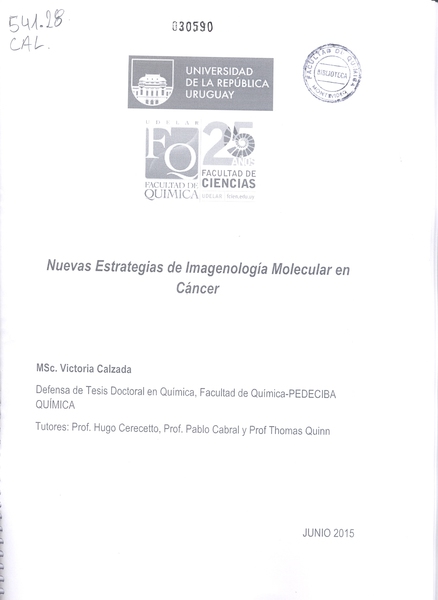Abstract
La imagenología molecular es una disciplina que abarca innumerables herramientas. Entre sus aplicaciones se encuentra el diagnóstico in vivo del cáncer con agentes que reconocen marcadores tumorales y que a su vez poseen óptimas características para obtención de imágenes. Asimismo, proporciona información clínicamente fundamental, permitiendo una correcta selección del tratamiento a seguir y el monitoreo de sus efectos. Detalles como la localización, tamaño, morfología y cambios estructurales de un área afectada pueden ser detectados a través de los métodos convencionales de imagen. Sin embargo, técnicas de imagenología molecular como la SPECT, PET y FMT, entre otras, son cada vez más utilizadas. Debido a su característica no invasiva la imagen molecular permite evaluar la patología en su contexto, siendo clave para entender el proceso tumoral, sin perturbar el ambiente y proporcionando información adicional a los métodos convencionales. La estadificación tumoral, detección de metástasis, cirugía guiada, así como la cuantificación de una lesión son diferentes aplicaciones en este área. En este contexto, es muy importante el conocimiento de marcadores tumorales y el desarrollo de nuevos agentes de imagenología molecular específicos de estos. Los aptámeros son oligonucleótidos (DNA o RNA) que tienen la característica de reconocer su blanco con alta afinidad y especificidad. Similar a los anticuerpos en estas características, los aptámeros presentan ventajas que los hacen interesantes para su aplicación como agentes de imagen o terapia. El Sgc8-c es una secuencia truncada del aptámero sgc8, el cual muestra una unión específica y con alta afinidad al receptor PTK7. Sgc8-c tiene solamente 41 bases y una Kd de 0.78 nM para este receptor. Si bien este receptor está presente en células normales, su sobreexpresión ha sido observada en cáncer de colon, tumores gástricos, cáncer de pulmón, próstata, mama e incluso en metástasis. Si bien, su participación en la oncogénesis parece ser clara, aun no es un receptor extensamente caracterizado. El presente trabajo consistió en la investigación y desarrollo del aptámero Sgc8-c como agente de imagenología molecular en cáncer. Para ello Sgc8-c fue modificado en su extremo 5’ con HYNIC, DOTA y se marcó con Tecnecio-99m y Galio-67 respectivamente. Asimismo el aptámero Sgc8-c fue marcado con Alexa647, para su evaluación como agente de imagen óptica en el infrarrojo cercano. Todos los agentes desarrollados fueron evaluados fisicoquímicamente y frente a diferentes líneas celulares tumorales. Finalmente, las características de biodistribución y farmacocinética fueron estudiadas y tres modelos tumorales en ratón fueron seleccionados para realizar imágenes. Resumen 3 Molecular imaging is a discipline that involves many tools. One of its major applications is the in vivo diagnosis of cancer, using molecular probes that recognize tumor markers and have optimal characteristics for imaging. It also provides clinically important information, allowing the correct choice of treatment options and monitoring their effects. Details such as the location, size, morphology and structural changes of an affected area can be detected by conventional imaging methods. Moreover, molecular imaging techniques such as SPECT, PET and FMT, among others, are increasingly used. Due to its minimal invasive characteristics, molecular imaging allows the evaluation of the pathology in context, being key to understanding tumor process without disturbing the environment and providing additional information to conventional methods. Tumor staging, detection of metastasis, guided surgery, as well as quantification of disease are different applications in this area. In this context, knowledge of tumor markers and the development of new targeted molecular imaging agents is very important. Aptamers are oligonucleotides (DNA or RNA), which have the characteristics to recognize their target with high affinity and specificity. Similar to antibodies in their molecular recognition properties, aptamers offer advantages that make them interesting for use as imaging agents or therapy. Sgc8-c is a truncated aptamer sequence, which exhibits specific binding and high affinity for the receptor PTK7. The Sgc8-c aptamer has only 41 bases, but its Kd for its receptor is 0.78 nM. Although this receptor is present in normal cells, its overexpression has been observed in colon, gastric tumors, lung, prostate, breast cancer and even their metastases. While participation in oncogenesis seems clear, the receptor needs to be characterized more extensively in vivo as a valid biomarker. The work presented describes the research and development of aptamer Sgc8-c as a molecular imaging agent for cancer. Sgc8-c was modified at its 5 'end with radiometal chelators HYNIC and DOTA and labeled with technetium-99m and gallium-67 respectively. Also, the Sgc8-c aptamer was labeled with the near infrared dye Alexa647 for evaluation as an optical imaging agent. All agents were developed and evaluated physicochemically against different tumor cell lines. Finally, the pharmacokinetics and biodistribution characteristics of the labeled Sgc8-c aptamer were studied and three mouse tumor models were selected for imaging.
Derechos
Información sobre Derechos de Autor
(Por favor lea este aviso antes de abrir los documentos u objetos)
La legislación uruguaya protege el derecho de autor sobre toda creación literaria, científica o artística, tanto en lo que tiene que ver con sus derechos morales, como en lo referente a los derechos patrimoniales con sujeción a lo establecido por el derecho común y las siguientes leyes (LEY 9.739 DE 17 DE DICIEMBRE DE 1937 SOBRE PROPIEDAD LITERARIA Y ARTISTICA CON LAS MODIFICACIONES INTRODUCIDAS POR LA LEY DE DERECHO DE AUTOR Y DERECHOS CONEXOS No. 17.616 DE 10 DE ENERO DE 2003, LEY 17.805 DE 26 DE AGOSTO DE 2004, LEY 18.046 DE 24 DE OCTUBRE DE 2006 LEY 18.046 DE 24 DE OCTUBRE DE 2006)
ADVERTENCIA - La consulta de este documento queda condicionada a la aceptación de las siguientes condiciones de uso: Este documento es únicamente para usos privados enmarcados en actividades de investigación y docencia. No se autoriza su reproducción con fines de lucro. Esta reserva de derechos afecta tanto los datos del documento como a sus contenidos. En la utilización o cita de partes debe indicarse el nombre de la persona autora.

